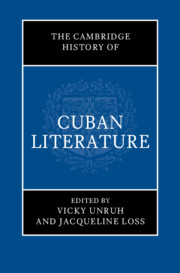Book contents
- The Cambridge History of Cuban Literature
- The Cambridge History of Cuban Literature
- Copyright page
- Dedication
- Contents
- Figures
- Contributors
- Acknowledgments
- Introduction Unfinished Histories
- Part I Literature in the Early Colony
- Part II Cuban Literature’s Long Nineteenth Century
- Part III Literary and Intellectual Culture in the Twentieth-Century Republic
- Part IV The Revolution’s Literary-Cultural Initiatives and Their Early Discontents
- 22 Beginnings
- 23 Imagining Cuba’s New Revolutionary Communities Through Film (1959–1989)
- 24 Shaping New Cultural Literacies
- 25 The Social Life of Music in Cuban Literary Culture
- 26 Casa de las Américas and Revolutionary Configurations of Latinoamericanismo
- 27 The Travels of Fiction in the Cuban Diaspora
- 28 Cuba’s Poetic Imaginary (1959–1989)
- 29 The Artistic Worlds of Guillermo Cabrera Infante
- 30 The Diasporic Odysseys of Reinaldo Arenas and His Writings
- Part V Cuba and Its Diasporas into the New Millennium
- Epilogue
- Select Bibliography
- Index
- References
23 - Imagining Cuba’s New Revolutionary Communities Through Film (1959–1989)
from Part IV - The Revolution’s Literary-Cultural Initiatives and Their Early Discontents
Published online by Cambridge University Press: aN Invalid Date NaN
- The Cambridge History of Cuban Literature
- The Cambridge History of Cuban Literature
- Copyright page
- Dedication
- Contents
- Figures
- Contributors
- Acknowledgments
- Introduction Unfinished Histories
- Part I Literature in the Early Colony
- Part II Cuban Literature’s Long Nineteenth Century
- Part III Literary and Intellectual Culture in the Twentieth-Century Republic
- Part IV The Revolution’s Literary-Cultural Initiatives and Their Early Discontents
- 22 Beginnings
- 23 Imagining Cuba’s New Revolutionary Communities Through Film (1959–1989)
- 24 Shaping New Cultural Literacies
- 25 The Social Life of Music in Cuban Literary Culture
- 26 Casa de las Américas and Revolutionary Configurations of Latinoamericanismo
- 27 The Travels of Fiction in the Cuban Diaspora
- 28 Cuba’s Poetic Imaginary (1959–1989)
- 29 The Artistic Worlds of Guillermo Cabrera Infante
- 30 The Diasporic Odysseys of Reinaldo Arenas and His Writings
- Part V Cuba and Its Diasporas into the New Millennium
- Epilogue
- Select Bibliography
- Index
- References
Summary
This chapter unpacks the hegemonic attitudes within the extensive anticolonial project of Cuban feature-length and documentary film from 1959 to 1989. The chapter first explores the centrality in and contributions to the New Latin American cinema movement of Cuba, the Cuban Film Institute (ICAIC), and Cuban film directors Julio García Espinosa, Tomás Gutiérrez Alea, Humberto Solás, and Santiago Álvarez. At the same time, the chapter makes visible the many accomplished though lesser-known creative agents who helped shape these directors’ model of auteur esthetics, demonstrating how films by Sara Gómez and Nicolás Guillén Landrián also constitute fundamental and critical contributions to the Cuban cinematic canon of the period, which typically privileged the contributions of white men.
Keywords
- Type
- Chapter
- Information
- The Cambridge History of Cuban Literature , pp. 368 - 383Publisher: Cambridge University PressPrint publication year: 2024



